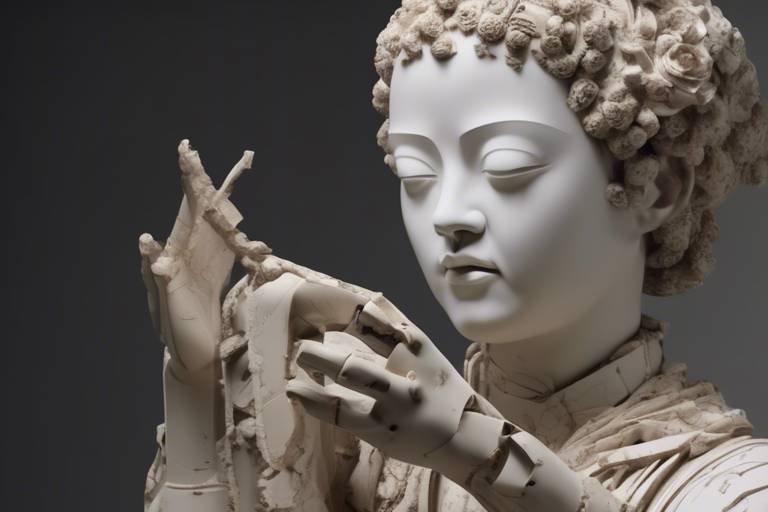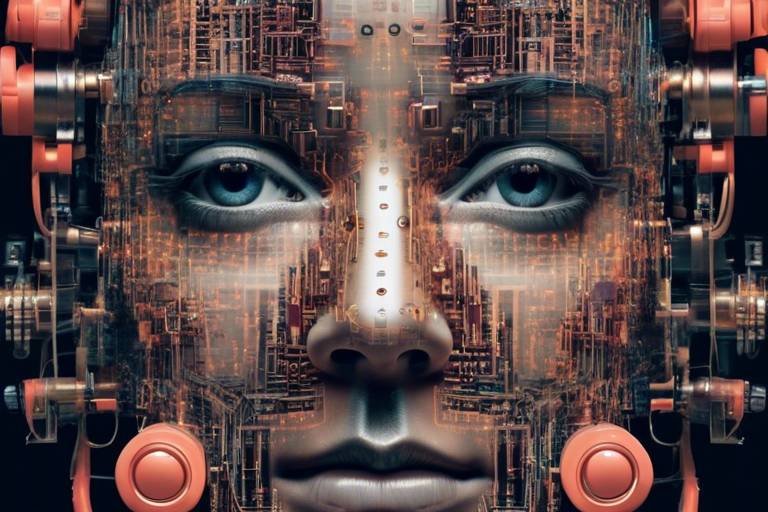The Evolution of AI in the Gaming Industry
Artificial Intelligence (AI) has come a long way in the gaming industry, evolving from simple algorithms that dictated basic behaviors to complex systems that create immersive, dynamic experiences. This transformative journey has not only enhanced gameplay but has also revolutionized character development and player engagement. Imagine stepping into a game where each character feels alive, adapting to your every move and decision—this is the magic of AI in gaming!
From the early days of gaming, where characters followed predictable patterns, to today's advanced AI that can learn and adapt, the evolution of AI is nothing short of astonishing. It’s like watching a caterpillar turn into a butterfly; the change is profound and beautiful. As we dive deeper into this topic, we will explore the historical context of AI in gaming, the technological advancements that have propelled its growth, and how it continues to shape player experiences.
As we embark on this journey, it’s essential to understand that AI is not just a tool but a partner in the gaming experience. It enhances our interaction with the game world, making it richer and more engaging. So, let's buckle up and explore how AI has transformed the gaming landscape!
To truly appreciate the present state of AI in gaming, we must first look back at its humble beginnings. In the early days, AI was primarily about simple decision-making algorithms. Games like Pong and Space Invaders utilized rudimentary AI that could follow basic rules, making them fun but predictable.
These early AI systems laid the foundation for future innovations. As technology advanced, so did the complexity of AI in games. The introduction of pathfinding algorithms in the 1980s allowed characters to navigate game worlds more intelligently, paving the way for richer gameplay experiences. Fast forward to today, and we see AI that can learn from players, adapting in real-time to create unique challenges.
The technological breakthroughs in AI have been monumental. Machine learning, neural networks, and natural language processing are just a few of the innovations that have propelled AI into the forefront of game development. These technologies enable developers to create games that are not only visually stunning but also deeply engaging.
Machine learning has become a game-changer in the industry. Developers now leverage algorithms that analyze player behavior, allowing them to create adaptive gameplay experiences. Imagine playing a game that learns your style—if you prefer stealth over combat, the game adjusts its challenges accordingly. This level of personalization keeps players engaged and invested in the game.
One fascinating application of AI is procedural content generation, where algorithms create vast, dynamic game worlds. This technology allows for endless exploration and replayability. Picture this: every time you log in, the world is different, filled with new quests and challenges. It’s like opening a new book every time you play!
Dynamic difficulty adjustment is another remarkable feature powered by AI. Algorithms assess player skill levels and adjust the game difficulty in real-time. This means you can enjoy a challenge without feeling overwhelmed. It’s like having a personal trainer in your gaming journey, always pushing you to improve while ensuring you don't lose motivation.
The evolution of NPC behavior through AI has also been significant. Gone are the days of static characters that merely follow scripted paths. Today, advanced algorithms create NPCs that respond to player actions in real-time, making the game world feel alive. These characters can express emotions, remember past interactions, and even change their behavior based on your choices. It’s akin to having a conversation with a friend who remembers your preferences!
The impact of AI on player experience cannot be overstated. From personalized content recommendations to immersive storytelling, AI has revolutionized how we interact with games. It’s not just about playing; it’s about experiencing a world tailored to you.
AI algorithms analyze player preferences to tailor experiences, enhancing satisfaction and retention in gaming communities. Imagine a game that suggests quests based on your previous choices—this level of personalization keeps players coming back for more!
Emotional AI plays a crucial role in crafting narratives that resonate with players. By understanding player emotions, games can create more impactful and memorable experiences. It’s like watching a movie that knows exactly how to tug at your heartstrings, making you feel every triumph and defeat.
As we look to the future, the possibilities for AI in gaming are endless. Emerging technologies are set to further transform the industry, offering exciting innovations that could redefine how we play and interact with games. Just imagine a game that uses virtual reality and AI to create a fully immersive experience where you are not just a player but a part of the story!
- How has AI changed the way games are developed? AI has allowed for more complex game mechanics, adaptive gameplay, and personalized experiences.
- Will AI replace human game designers? While AI can enhance game design, human creativity and intuition remain irreplaceable.
- What is procedural content generation? It’s a method where AI algorithms create game content dynamically, allowing for unique experiences each time.

Historical Context of AI in Gaming
The journey of artificial intelligence (AI) in gaming is nothing short of fascinating. It all began in the early 1950s, a time when computers were as large as rooms and barely had the processing power of today’s smartphones. Back then, game developers relied on rudimentary algorithms that could perform simple tasks, like making decisions based on predefined rules. The first significant breakthrough came with the creation of computer chess programs, which utilized basic AI to simulate human decision-making. This early form of AI laid the groundwork for what would later evolve into the complex systems we see in modern gaming.
Fast forward to the 1980s and 1990s, when gaming began to take a more serious turn with the advent of home consoles and personal computers. Titles like Pac-Man and Space Invaders showcased AI that could control enemy movements, albeit in a simplistic manner. These games were groundbreaking for their time, introducing players to the idea that they were not just competing against a static environment but against intelligent entities. The AI was still limited; it operated on fixed patterns that could be memorized, making the gameplay predictable after a few rounds.
As technology advanced, so did the complexity of AI in games. The introduction of real-time strategy (RTS) games in the late 90s marked a significant turning point. Titles like StarCraft and Civilization utilized more advanced AI algorithms that could adapt to player strategies, making each match unique and challenging. This was a leap forward, as players were no longer just facing predictable foes but rather opponents that could learn and adjust their tactics based on player behavior.
In the early 2000s, AI took another significant step forward with the incorporation of fuzzy logic and behavior trees. These technologies allowed developers to create more sophisticated NPCs that could exhibit a range of behaviors rather than just following a set path. For instance, in games like Halo and Half-Life, NPCs began to demonstrate more human-like reactions, such as taking cover, flanking, and even retreating when overwhelmed. This evolution in AI behavior made the gaming experience more immersive and engaging, drawing players deeper into the game world.
As we moved into the 2010s, the rise of machine learning and neural networks further transformed the landscape of AI in gaming. Developers began to harness these technologies to create adaptive gameplay experiences. For example, AI could now analyze player actions in real-time and adjust the game environment accordingly. This meant that no two gaming sessions would ever be the same, keeping players on their toes and enhancing replayability.
In summary, the historical context of AI in gaming is a testament to how far we’ve come. From simple algorithms to complex adaptive systems, AI has continuously evolved, enriching the gaming experience and pushing the boundaries of what is possible. As we look back, it’s clear that each advancement has been instrumental in shaping the interactive worlds we enjoy today, paving the way for even more exciting innovations in the future.

Advancements in AI Technology
The landscape of gaming has been dramatically reshaped by the relentless march of artificial intelligence. As technology has advanced, so too has the sophistication of AI systems, paving the way for experiences that were once confined to the realm of science fiction. From the early days of simple algorithms to the current era of machine learning and neural networks, AI has become a cornerstone of modern game design. But what exactly has driven these advancements, and how do they manifest in the gaming world?
One of the most significant breakthroughs in AI technology is the introduction of machine learning. This powerful approach allows developers to create games that adapt to player behaviors and preferences. Imagine a game that learns how you play, adjusting its challenges and rewards in real-time to keep you engaged. This is not just a dream; it's a reality made possible by machine learning algorithms, which analyze vast amounts of data to identify patterns and make predictions. The result? A gaming experience that feels uniquely tailored to each player.
Another fascinating development is procedural content generation. This technique uses algorithms to create game worlds dynamically, meaning that no two playthroughs are ever the same. Instead of relying on pre-designed levels, developers can use AI to generate vast landscapes, intricate dungeons, and even entire ecosystems on the fly. This not only enhances replayability but also immerses players in a living, breathing environment that responds to their actions. Picture exploring an endless forest where every tree, rock, and creature is generated based on your decisions—how cool is that?
Moreover, AI has significantly improved the concept of dynamic difficulty adjustment. Gone are the days when players would either breeze through a game or hit a wall of frustrating difficulty. With advanced algorithms, games can now assess a player's skill level in real-time and adjust the challenge accordingly. This means that if you're struggling, the game will ease up a bit; conversely, if you're breezing through, it will ramp up the difficulty to keep you on your toes. It’s like having a personal trainer for your gaming experience, ensuring that you are always challenged but never overwhelmed.
In addition to these advancements, the role of natural language processing (NLP) has also emerged as a game-changer in AI technology. NLP allows for more immersive interactions between players and non-player characters (NPCs). Imagine chatting with a character in your favorite game, discussing strategies or lore, and having a genuinely engaging conversation. This level of interaction not only enhances storytelling but also creates emotional connections that can make a game unforgettable.
As we look ahead, the future of AI in gaming seems brighter than ever. With continuous advancements in technology, we can expect even more innovative features that will push the boundaries of what's possible. The integration of AI not only enhances gameplay but also enriches the overall player experience, making gaming more engaging, personalized, and immersive than ever before.
- What is machine learning in gaming? - Machine learning refers to algorithms that enable games to adapt and respond to player behavior, creating personalized experiences.
- How does procedural content generation work? - This technique uses AI algorithms to dynamically create game worlds, ensuring unique experiences for each player.
- What is dynamic difficulty adjustment? - This feature allows games to automatically adjust their difficulty based on the player's skill level to maintain engagement.
- How does natural language processing enhance gaming? - NLP enables more realistic interactions with NPCs, allowing for engaging conversations and deeper storytelling.

Machine Learning in Game Design
Machine learning has become a game-changer in the world of game design, allowing developers to craft experiences that are not only engaging but also adaptable. Imagine playing a game that learns from your every move, adjusting its strategies and challenges based on your unique playstyle. This isn't just a fantasy anymore; it's a reality made possible by the powerful algorithms that drive machine learning. With the ability to analyze vast amounts of data, these algorithms enable developers to create adaptive gameplay experiences that evolve over time, keeping players on their toes.
One of the most exciting aspects of machine learning in game design is its capacity for personalization. By examining player behavior, machine learning models can identify patterns and preferences, allowing games to tailor their content to individual players. For example, if a player tends to favor stealth strategies over brute force, the game can adjust its scenarios to offer more stealth-based challenges. This level of personalization not only enhances the overall gaming experience but also fosters a deeper connection between the player and the game.
Furthermore, machine learning facilitates dynamic difficulty adjustment, a feature that ensures players remain challenged without feeling overwhelmed. Imagine you're breezing through a level, and suddenly, the game ramps up the difficulty to keep you engaged. This is achieved through real-time assessments of player performance, where AI algorithms analyze your skills and adjust the game’s challenges accordingly. This not only maintains player interest but also promotes a sense of achievement, as players feel they are constantly improving and overcoming obstacles.
Additionally, the use of machine learning extends to game testing and development. Traditionally, testing a game for bugs and balance issues required extensive human input, often leading to delays in release. However, with machine learning, developers can automate much of this process. AI can simulate thousands of gameplay scenarios to identify potential flaws and suggest improvements, expediting the development cycle and ensuring a smoother launch.
To illustrate the impact of machine learning in game design, consider the following table that highlights key areas where this technology is making waves:
| Application | Description |
|---|---|
| Adaptive Gameplay | Games learn from player actions to modify challenges and experiences. |
| Dynamic Difficulty Adjustment | Real-time adjustments based on player performance keep engagement high. |
| Personalization | Content tailored to individual preferences enhances player satisfaction. |
| Automated Testing | AI simulates gameplay to identify bugs and balance issues, speeding up development. |
In conclusion, machine learning is revolutionizing game design by creating more immersive, personalized, and dynamic gaming experiences. As developers continue to harness the power of AI, we can expect to see even more innovative applications that will redefine how we interact with video games. The future of gaming is not just about playing; it’s about experiencing a world that understands you and adapts to your unique style.

Procedural Content Generation
When we talk about , we’re diving into one of the most exciting and revolutionary aspects of game design. Imagine stepping into a game world that feels endless, where each playthrough is a unique adventure waiting to unfold. That's the magic of procedural generation! This technique allows developers to create vast, dynamic game environments that adapt and change, offering players a fresh experience every time they hit 'start'.
The beauty of procedural generation lies in its ability to utilize algorithms to create content algorithmically rather than manually. This means that instead of developers painstakingly crafting every single level or environment, they can set parameters and let the computer do the heavy lifting. This not only saves time but also opens the door to a level of creativity that would be impossible otherwise. For example, games like No Man's Sky and Minecraft have harnessed this technology to create expansive worlds filled with endless possibilities.
To put it simply, procedural generation works by using specific rules and randomness to create game assets such as landscapes, quests, and even entire worlds. Think of it like baking a cake: you have a recipe (the algorithm) that allows you to mix ingredients (game elements) in different ways to create a variety of cakes (game environments). Each time you bake, you can tweak the ingredients or the method slightly, resulting in a new and exciting cake that still retains the essence of the original recipe.
One of the most significant advantages of procedural content generation is its ability to enhance replayability. Players are naturally drawn to games that offer something new each time they play. With procedural generation, developers can ensure that no two gaming experiences are the same, keeping players engaged and coming back for more. Furthermore, it can significantly reduce development costs and time, allowing studios, especially indie ones, to produce high-quality games without breaking the bank.
However, it’s not all rainbows and sunshine. While procedural generation can create vast and varied worlds, it can sometimes lead to a lack of depth or coherence in the gameplay experience. If not implemented carefully, the randomly generated content might feel repetitive or uninspired. Developers must strike a balance between randomness and meaningful design to ensure that the generated content is not just different, but also engaging and enjoyable.
In conclusion, procedural content generation is a powerful tool that has transformed the gaming landscape. It enables the creation of immersive worlds and experiences that captivate players, pushing the boundaries of what games can achieve. As technology continues to evolve, we can only imagine the heights that procedural generation will reach, offering players even more dynamic and enriching experiences.
- What is procedural content generation?
Procedural content generation is a method of creating game content algorithmically rather than manually, allowing for dynamic and varied game worlds.
- How does procedural generation improve replayability?
By generating unique environments and experiences each time a player starts a new game, procedural generation keeps the gameplay fresh and engaging.
- What are some popular games that use procedural generation?
Notable examples include No Man's Sky, Minecraft, and Spelunky, each showcasing the potential of this technology.
- Are there any downsides to procedural content generation?
Yes, if not designed carefully, it can lead to content that feels shallow or repetitive, lacking the depth of manually crafted environments.

Dynamic Difficulty Adjustment
Dynamic Difficulty Adjustment (DDA) is a fascinating aspect of artificial intelligence in gaming that tailors the challenge level of a game to suit the player's skill and experience. Imagine stepping into a game where the challenges adapt to your abilities, like a personal trainer who knows just how hard to push you for optimal growth. This is precisely what DDA aims to achieve, creating a more engaging and enjoyable experience for players of all skill levels.
Historically, games were often designed with a one-size-fits-all approach to difficulty. Players would either breeze through levels or find themselves stuck in frustrating loops, leading to disengagement. However, with the advent of AI, developers can now implement sophisticated algorithms that monitor player performance in real-time. These algorithms analyze various metrics, such as how quickly a player completes a level, how many times they die, and their overall gameplay style. Based on this data, the game can dynamically adjust its difficulty settings, ensuring that players remain challenged but not overwhelmed.
For instance, if a player is consistently failing to defeat a boss or struggling with a particular puzzle, the game might reduce the enemy's health or provide additional hints. Conversely, if a player is breezing through levels with ease, the game could ramp up the challenge by increasing enemy aggression or introducing more complex puzzles. This adaptability not only enhances the player experience but also encourages longer play sessions, as players feel a sense of achievement without the frustration of insurmountable challenges.
The implementation of DDA can take various forms, from subtle adjustments in enemy behavior to significant changes in game mechanics. Here’s a quick overview of how DDA can manifest in games:
| Adjustment Type | Description |
|---|---|
| Enemy Strength | Alters the health and damage output of enemies based on player performance. |
| Resource Availability | Modifies the amount of health packs, ammunition, or power-ups available in the game. |
| Puzzle Complexity | Adjusts the difficulty of puzzles or challenges based on how quickly they are solved. |
As exciting as DDA sounds, it's not without its challenges. Developers must strike a delicate balance; too much adjustment can lead to a lack of satisfaction in overcoming challenges, while too little can frustrate players. The key is to create a seamless experience where players feel like they are in control, yet still have the thrill of facing formidable challenges. It's a dance between AI and human emotion, where the goal is to keep players engaged and satisfied.
In conclusion, Dynamic Difficulty Adjustment represents a significant leap forward in how games interact with players. By leveraging AI to create a responsive gaming experience, developers can ensure that players remain invested, challenged, and ultimately, entertained. As technology continues to evolve, we can only imagine the exciting possibilities that lie ahead for DDA and the gaming industry as a whole.
- What is Dynamic Difficulty Adjustment?
Dynamic Difficulty Adjustment (DDA) is a feature that allows games to automatically change their difficulty level based on the player's skill and performance. - How does DDA improve player experience?
DDA keeps players engaged by providing an appropriate level of challenge, preventing frustration, and enhancing the overall gaming experience. - Can DDA be turned off in games?
Many games offer options to disable DDA, allowing players to choose a fixed difficulty level if they prefer. - Is DDA used in all games?
No, while DDA is becoming more common, not all games utilize this feature. Some games stick to traditional fixed difficulty settings.

AI in Non-Player Characters (NPCs)
The evolution of artificial intelligence has dramatically transformed the landscape of Non-Player Characters (NPCs) in gaming. In the early days, NPCs were little more than static figures, often designed to follow simple scripts and respond to player actions in predictable ways. They were akin to cardboard cutouts, lacking depth and personality. However, as technology advanced, developers began to harness the power of AI to breathe life into these characters, making them more interactive and realistic. Today, NPCs can exhibit complex behaviors, adapt to player choices, and even engage in meaningful conversations, making the gaming experience all the more immersive.
One of the most significant breakthroughs in NPC AI has been the integration of sophisticated algorithms that allow these characters to learn and evolve. For instance, using techniques like reinforcement learning, NPCs can analyze player actions and adjust their strategies accordingly. This means that the way an NPC reacts to a player can change over time, creating a dynamic and engaging environment. Imagine playing a role-playing game where the shopkeeper remembers your previous purchases and adjusts their inventory based on your preferences. This level of personalization not only enhances gameplay but also fosters a deeper connection between players and the game world.
Moreover, emotional AI is playing an increasingly vital role in the development of NPCs. By analyzing player emotions through various inputs, such as voice tone or in-game choices, NPCs can respond in ways that feel more authentic and relatable. This emotional intelligence enables characters to react to situations with empathy or hostility, depending on the context, thereby enriching the storytelling experience. Players can find themselves genuinely affected by the decisions made by these characters, leading to a more profound emotional investment in the game.
Additionally, the use of procedural generation techniques allows for the creation of vast, diverse NPC populations that can interact in unique ways. Instead of having a handful of generic characters, games can now feature towns filled with individuals who have their own stories, routines, and relationships. This adds layers of complexity to the game world, making it feel alive and responsive. As players explore, they can uncover intricate narratives and engage with NPCs that react differently based on their actions, creating a rich tapestry of interactions.
In summary, the advancements in AI have revolutionized the role of NPCs in gaming. No longer mere background actors, these characters have become integral to the gaming experience, offering players a more engaging and personalized journey. As AI technology continues to evolve, we can only imagine the possibilities that lie ahead for NPCs, paving the way for even more immersive and interactive gaming experiences.
- What is the role of AI in NPCs? AI enhances NPC behavior, making them more interactive and realistic, allowing for dynamic responses to player actions.
- How do NPCs learn from player interactions? NPCs use algorithms like reinforcement learning to adapt their behaviors based on player choices and strategies.
- Can NPCs exhibit emotions? Yes, emotional AI enables NPCs to respond to players in ways that reflect empathy or other emotional states, enriching the gaming experience.
- What is procedural generation in NPC design? Procedural generation allows developers to create diverse NPC populations with unique traits and stories, enhancing the game's depth.

Impact on Player Experience
The impact of artificial intelligence on player experience in gaming is nothing short of revolutionary. Imagine stepping into a virtual world where every decision you make influences the environment around you. AI has made this possible, transforming static gameplay into a dynamic adventure that feels personal and engaging. It's like having a conversation with a friend who knows you inside and out, responding to your preferences and actions in real-time. With AI, games are no longer just about completing levels; they are about creating an experience that resonates with each player on an individual level.
One of the most significant shifts has been in how games offer personalized content recommendations. AI algorithms analyze a player's behavior, preferences, and playstyle to curate experiences that feel tailor-made. For instance, if a player enjoys stealth mechanics over brute force, AI can suggest missions or challenges that align with that preference. This level of personalization not only enhances satisfaction but also fosters a sense of belonging within gaming communities. Players feel valued when games recognize their unique styles and adapt accordingly.
Moreover, emotional AI is playing a crucial role in storytelling within games. Gone are the days when narratives were linear and predictable. Today, with the help of AI, game developers can create rich, branching storylines that respond to players' emotional choices. This means that every decision can lead to different outcomes, making each playthrough unique. It’s akin to being the protagonist in your favorite movie, where your choices dictate the plot's direction. This level of interactivity is what keeps players coming back for more, eager to explore the myriad paths their journey can take.
To illustrate the impact of AI on player experience, consider the following table that summarizes key areas where AI enhances gameplay:
| Area of Impact | Description |
|---|---|
| Personalized Content | AI analyzes player behavior to offer tailored game experiences and recommendations. |
| Dynamic Storytelling | Emotional AI creates narratives that adapt based on player decisions, enhancing engagement. |
| Real-time Feedback | AI assesses player performance and adjusts challenges to maintain an optimal difficulty level. |
Furthermore, AI's ability to provide real-time feedback is a game-changer. Imagine playing a racing game where the AI monitors your performance and adjusts the difficulty on the fly. If you're cruising through the race, the AI ramps up the challenge, introducing tougher opponents or more complex tracks. Conversely, if you're struggling, it can ease off, ensuring that the experience remains enjoyable rather than frustrating. This dynamic difficulty adjustment keeps players engaged and motivated, allowing them to enjoy the game at their own pace.
In conclusion, the integration of AI in gaming has fundamentally transformed player experience. From personalized content and emotional storytelling to real-time feedback and dynamic challenges, AI is shaping the future of gaming in ways we are just beginning to understand. As technology continues to evolve, we can only imagine the exciting possibilities that lie ahead, making every gaming session an unforgettable experience.
- How does AI personalize gaming experiences? AI analyzes player data to tailor content and challenges that align with individual preferences.
- What is emotional AI in gaming? Emotional AI enhances storytelling by adapting narratives based on player choices and emotional responses.
- Can AI make games too easy or too hard? AI is designed to adjust difficulty dynamically, ensuring a balanced challenge that keeps players engaged.

Personalization and Recommendations
In the ever-evolving world of gaming, personalization and tailored recommendations have emerged as critical components that enhance player engagement and satisfaction. Imagine stepping into a game where every choice, every interaction, and every storyline feels uniquely crafted just for you. That’s the magic of AI-driven personalization! By leveraging advanced algorithms, game developers can analyze a player's behavior, preferences, and play style to create an experience that resonates deeply with individual gamers.
Consider how streaming services like Netflix recommend shows based on your viewing habits. Similarly, gaming platforms utilize AI algorithms to curate game suggestions that align with your interests. For instance, if you frequently gravitate towards action-packed adventures, the system will prioritize recommending similar titles, ensuring that you’re always engaged with content that excites you. This not only enhances your gaming experience but also fosters a sense of connection with the game itself.
Additionally, personalization extends beyond just recommendations. Many modern games employ AI to adapt in-game content dynamically. This can include altering the storyline based on your choices, adjusting character interactions, or even modifying the game environment to reflect your actions. Such an immersive approach makes players feel like they are part of a living, breathing world where their decisions truly matter.
Furthermore, the integration of machine learning allows these systems to improve over time. As players continue to engage with the game, the AI learns from their actions, refining its recommendations and personalizations. This creates a feedback loop that not only keeps the gameplay fresh but also encourages players to explore new aspects of the game they might not have considered before.
To illustrate this, let’s look at a simple table that outlines how personalization can manifest in gaming:
| Aspect | Personalization Example |
|---|---|
| Game Recommendations | Suggesting titles based on previous gameplay history. |
| Dynamic Storylines | Altering plot points based on player choices. |
| Character Interactions | NPCs reacting differently based on player reputation or past actions. |
| Gameplay Difficulty | Adjusting challenges based on player skill level. |
This table highlights just a few ways that personalization can enhance the gaming experience, making it more engaging and tailored to each player. In a world where gamers have countless options at their fingertips, standing out is crucial, and personalization is the key to unlocking deeper player satisfaction.
As we look to the future, the role of AI in personalization and recommendations will only grow more sophisticated. With advancements in natural language processing and further developments in machine learning, we can expect even more nuanced and tailored experiences that cater to our unique gaming preferences. So, the next time you dive into a game, remember that it might just know you better than you think!
- How does AI personalize my gaming experience? AI analyzes your gameplay behavior, preferences, and choices to tailor recommendations and in-game content just for you.
- Can I influence the personalization? Yes! Your choices and interactions directly impact how the AI adapts and personalizes your experience.
- Will all games have personalization features in the future? While not all games currently offer this, the trend is moving towards more personalized experiences, especially as AI technology advances.
- How does this affect game replayability? Personalized experiences can enhance replayability by providing new storylines and challenges based on your past decisions.

Emotional AI in Storytelling
In the realm of gaming, storytelling has always been a powerful force that captivates players and draws them into fantastical worlds. But what if I told you that emotional AI is taking this storytelling experience to a whole new level? Imagine a game where the characters not only react to your actions but also adapt their emotional responses based on your choices, creating a narrative that feels uniquely yours. This is not just a dream; it is rapidly becoming a reality thanks to advancements in AI technology.
Emotional AI refers to the ability of machines to recognize, interpret, and simulate human emotions. In gaming, this means that characters can respond to players in ways that feel genuine and relatable. For instance, if a player makes a choice that leads to a tragic outcome, the NPCs (non-player characters) can express grief, anger, or sadness, making the player feel the weight of their decisions. This level of interaction transforms the gaming experience from a passive activity into an emotional journey that resonates deeply with players.
One of the most exciting aspects of emotional AI in storytelling is its ability to create dynamic narratives. Unlike traditional games where the story is linear and predetermined, emotional AI allows for branching storylines that evolve based on player interactions. For example, if a player consistently chooses to help others, the game might reward them with allies who trust them and share their own backstories. Conversely, if a player opts for selfish choices, they might find themselves facing moral consequences, such as betrayal or isolation. This adaptive storytelling not only enhances immersion but also encourages players to think critically about their actions.
Moreover, emotional AI can enhance character development, making NPCs more relatable and human-like. Developers can program AI to analyze player behavior and adjust the NPCs' personalities accordingly. This means that if a player is empathetic and caring, the NPCs might mirror that behavior, forming bonds that feel authentic. On the flip side, if a player is aggressive, the NPCs may become wary or hostile, leading to a rich tapestry of interactions that keep players engaged and invested in the game world.
As we look to the future, the potential for emotional AI in storytelling is immense. Imagine games that can not only read your emotional state through your gameplay but also tailor the narrative to evoke specific feelings. This could lead to experiences that are not just entertaining but also therapeutic, helping players process their emotions in a safe environment. The integration of emotional AI into gaming is still in its infancy, but the possibilities are limitless.
In conclusion, emotional AI is revolutionizing storytelling in gaming by creating more immersive, adaptive, and emotionally resonant experiences. As developers continue to explore the depths of this technology, we can expect to see games that challenge our perceptions, evoke deeper feelings, and ultimately redefine what it means to be a player in a virtual world.
- What is emotional AI? Emotional AI is the capability of machines to recognize and respond to human emotions, enhancing interactions in gaming.
- How does emotional AI improve storytelling in games? It allows for dynamic narratives that adapt to player choices, making the story feel personalized and impactful.
- Can emotional AI make NPCs more realistic? Yes, emotional AI enables NPCs to reflect player behavior and emotions, resulting in more relatable interactions.
- What future developments can we expect from emotional AI in gaming? Future developments may include games that tailor narratives based on player emotions, creating therapeutic and immersive experiences.

Future Trends in AI and Gaming
As we look ahead, the future of AI in gaming is teeming with possibilities that promise to reshape how we play, create, and interact with games. Imagine stepping into a world where every character you meet is not just a programmed entity but a dynamic personality that adapts to your choices and actions. This is no longer a distant dream; it's a tangible future on the horizon, fueled by advancements in artificial intelligence.
One of the most exciting trends is the integration of virtual reality (VR) and augmented reality (AR) with AI. Picture this: you’re in a game where the environment responds to your emotions, thanks to AI analyzing your facial expressions and voice tone. This level of immersion could revolutionize the gaming experience, making it not just a pastime but a deeply personal journey. Developers are already experimenting with these technologies, and the results are nothing short of astonishing.
Moreover, AI-driven storytelling is set to take narrative experiences to new heights. By leveraging machine learning, game designers can create branching storylines that evolve based on player decisions, leading to unique experiences for every gamer. This means that no two playthroughs are exactly the same, enhancing replayability and player engagement. Imagine a game where the storyline adapts to your moral choices, creating a narrative that feels personal and impactful.
In addition, the rise of cloud gaming is likely to influence AI's role in gaming significantly. With the ability to stream high-quality games on various devices, AI can optimize performance in real-time, ensuring smooth gameplay regardless of hardware limitations. This shift could democratize access to advanced gaming experiences, allowing more players to enjoy complex AI-driven worlds without needing top-of-the-line equipment.
Another area to watch is the use of emotional AI. As developers strive to create more relatable characters, emotional AI can analyze players' reactions and adjust dialogues and interactions accordingly. This could lead to more meaningful connections between players and characters, enhancing the emotional weight of gaming narratives. Imagine playing a game where your decisions not only affect the plot but also how characters perceive and react to you, creating a rich tapestry of relationships.
Furthermore, ethical AI is becoming a critical consideration. As AI systems become more sophisticated, ensuring that they operate fairly and transparently is essential. Developers will need to address issues such as bias in AI algorithms and the implications of AI decision-making in gameplay. This could lead to the establishment of industry standards for ethical AI use, fostering trust and safety in gaming environments.
In conclusion, the future of AI in gaming is not just about enhancing graphics or creating smarter NPCs; it’s about transforming the very essence of gameplay. As technology evolves, so too will our experiences, leading to a landscape where games are more immersive, personalized, and emotionally resonant than ever before. Are you ready to embrace this new era of gaming?
- What role will AI play in future game design? AI will enable more personalized experiences, adaptive gameplay, and dynamic storytelling.
- How will emotional AI change character interactions? Emotional AI will allow characters to respond to players' emotions, creating deeper connections.
- What is the impact of cloud gaming on AI? Cloud gaming will allow AI to optimize performance in real-time, making advanced games accessible to more players.
- Are there ethical concerns with AI in gaming? Yes, developers must address issues like bias and transparency in AI algorithms to ensure fair gameplay.
Frequently Asked Questions
- What is the role of AI in modern gaming?
AI plays a crucial role in modern gaming by enhancing gameplay experiences, creating realistic non-player characters (NPCs), and personalizing player interactions. It helps developers design games that adapt to player behavior, making each gaming session unique and engaging.
- How has AI evolved in the gaming industry?
AI has evolved significantly from simple algorithms in early games to sophisticated machine learning models that can analyze player behavior and create dynamic environments. Today, AI can adjust game difficulty in real-time and generate vast game worlds procedurally, enhancing replayability.
- What is machine learning and how is it used in games?
Machine learning is a subset of AI that allows systems to learn from data and improve over time. In gaming, it is used to create adaptive gameplay experiences, where the game learns from player actions and adjusts accordingly, providing a more personalized experience.
- Can AI create entire game worlds?
Yes! AI-driven procedural content generation enables developers to create expansive and dynamic game worlds that evolve based on player interactions. This technology not only saves time but also increases the variety and depth of gameplay.
- What is dynamic difficulty adjustment?
Dynamic difficulty adjustment is an AI feature that assesses a player's skill level in real-time and modifies the game's difficulty to keep it challenging yet enjoyable. This ensures players remain engaged without feeling overwhelmed or bored.
- How do AI algorithms enhance NPC behavior?
AI algorithms enhance NPC behavior by making them more responsive and realistic. Instead of following scripted paths, NPCs can react to player actions and decisions, creating a more immersive and interactive gaming experience.
- What impact does AI have on player experience?
AI significantly improves player experience by providing personalized content recommendations, enhancing storytelling through emotional AI, and creating immersive gameplay environments that resonate with players on a deeper level.
- What is emotional AI in gaming?
Emotional AI refers to the use of artificial intelligence to understand and respond to players' emotions. By analyzing player reactions, emotional AI can craft narratives that are more impactful and memorable, making the gaming experience richer and more engaging.
- What are the future trends for AI in gaming?
Future trends for AI in gaming include advancements in virtual reality, augmented reality, and further integration of machine learning to create even more personalized and immersive experiences. Innovations like AI-driven storytelling and enhanced NPC interactions are also on the horizon.



















